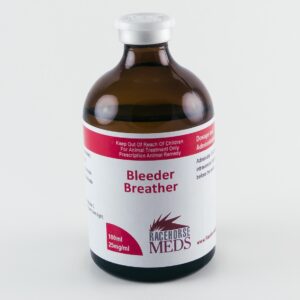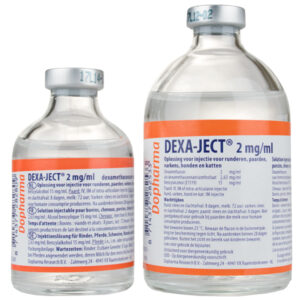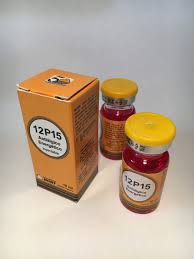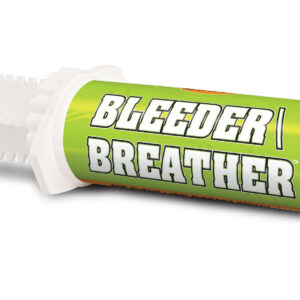Ketoprofen Injection is a sterile injection containing 100mg/mL Ketoprofen for intramuscular or slow intravenous injection in horses and cattle.
Ketofen 10% solution for injection.
Presentation of Ketoprofen Injection
A clear, sterile, aqueous solution for injection containing 100 mg/ml ketoprofen. Benzyl alcohol is added at 10 mg/ml as a preservative.
Uses for Ketoprofen Injection
Ketoprofen is a potent, non-narcotic, non-steroidal anti-inflammatory agent with analgesic and anti-pyretic properties.
In the horse
KETOFEN 10% is indicated for the alleviation of inflammation and pain associated with musculo-skeletal disorders. It is also indicated for the alleviation of visceral pain associated with colic.
In cattle
KETOFEN 10% is indicated for:
The supportive treatment of parturient paresis associated with calving;
Reducing the pyrexia and distress associated with bacterial respiratory disease when used in conjunction with antimicrobial therapy as appropriate;
Improving the recovery rate in acute clinical mastitis, including acute endotoxin mastitis, caused by gram negative micro-organisms, in conjunction with antimicrobial therapy;
Reducing oedema of the udder associated with calving.
In pigs
KETOFEN 10% is indicated for:
Reducing the pyrexia and respiratory distress associated with bacterial or viral respiratory disease when used in conjunction with antimicrobial therapy as appropriate.
The supportive treatment of Mastitis Metritis Agalactia Syndrome in sows, in conjunction with antimicrobial therapy as appropriate.
Dosage and administration
Horse
For use in musculo-skeletal conditions, the recommended dosage is 2.2 mg/kg ketoprofen, i.e. 1 ml of KETOFEN 10% per 45 kg bodyweight, administered by intravenous injection once daily for up to 3 to 5 days.
For use in equine colic, the recommended dosage is 2.2 mg/kg (1 ml per 45kg) bodyweight, given by intravenous injection for immediate effect. A second injection may be given if colic recurs.
Ketoprofen Injection for Cattle
The recommended dose is 3 mg ketoprofen per kg bodyweight, i.e. 1 ml of KETOFEN 10% per 33 kg bodyweight, administered by intravenous or deep intramuscular injection once daily for up to 3 days.
Ketoprofen Injection for Pigs
The recommended dose is 3mg ketoprofen per kg bodyweight, i.e. 1ml of KETOFEN 10% per 33kg bodyweight administered once by deep intramuscular injection.
Contra-indications, warnings, etc
For animal treatment only.
Avoid intra-arterial injection.
As the effects of ketoprofen on fertility, pregnancy or foetal health in horses have not been determined, KETOFEN 10% should not be administered to pregnant mares. KETOFEN 10% may be given to pregnant and lactating cattle and is indicated for use in lactating sows.
Do not administer to horses, cattle or pigs that have previously shown a hypersensitivity to ketoprofen.
In case of accidental self injection seek medical advice. Wash hands after use.
Avoid splashes on the skin and eyes. Irrigate thoroughly with water should this occur. If irritation persists seek medical advice.
Do not administer other non-steroidal anti-inflammatory drugs (NSAIDs) concurrently or within 24 hours of each other. Some NSAIDs may be highly bound to plasma proteins and compete with other highly bound drugs which can lead to toxic effects.
Do not exceed the stated dose or the duration of treatment. Use is contraindicated in animals suffering from cardiac, hepatic or renal disease, where there is the possibility of gastro-intestinal ulceration or bleeding, where there is evidence of a blood dyscrasia or hypersensitivity to the product. Use in any animal less than 6 weeks of age or in aged animals may involve additional risk. If such use can not be avoided, animals may require a reduced dosage and careful management.
Avoid use in any dehydrated, hypovolaemic or hypotensive animal as there is a potential risk of increased renal toxicity.
Concurrent administration of nephrotoxic drugs should be avoided.
Withdrawal periods
Horses, cattle and pigs must not be slaughtered for human consumption during treatment.
There is no withholding period necessary for the milk of treated cattle.
Animals may be slaughtered for human consumption only after the following periods from the last treatment:-
Horses
Meat – 1 day
Cattle
Meat – following intravenous administration 1 day





Reviews
There are no reviews yet.